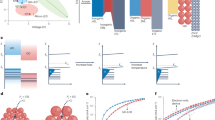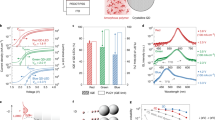Abstract
White quantum dot light-emitting diodes (QD-LEDs) have been a promising candidate for high-efficiency and color-saturated displays. Here, we report a simply solution-processed white QD-LED using ZnO QDs as emitters. The device is demonstrated with a maximum luminance of 300 cd/m2, exhibiting the Commission Internationale de l’Enclairage coordinates of (0.33, 0.33). The unencapsulated white QD-LED has a long lifetime of 120 h. These results indicate that ZnO QDs provides an alternate and effective approach to achieve high-performance white QD-LEDs and also other optoelectronic devices.
Similar content being viewed by others
Avoid common mistakes on your manuscript.
1 Introduction
Quantum dot LEDs (QD-LEDs) have been attracting much attention in the past few years since they possess unique properties of the tunable emission wavelengths by controlling the size of QDs, highly saturated emission, narrow emission with small full width at half maxima (FWHM), solution process, and compatible with flexible substrates [1–3]. Especially, the commercialization of white QD-LEDs is expanding to high-volume applications, including general solid-state lighting [4] and backlight for liquid–crystal displays [5]. White QD-LEDs can achieve a warmly white shade and a good spectral overlap with the sensitivity function of human eye, which in turn increases the efficiency of the light source [6]. Herein, we report the design and fabrication process of white QD-LED with ZnO QDs as emitters to obtain white light.
2 Experiment
ZnO QDs were prepared by the method as follows. At first, 0.1 M zinc acetate dihydrate (Zn(Ac)2·2H2O) was dissolved in methanol at room temperature. Then, 0.3 M potassium hydroxide (KOH) in methanol solution was added drop-wise at 40 °C with magnetic stirring. The stirring process was kept at 40 °C for 1 h at atmosphere. The prepared product was collected by centrifugation and then washed twice with methanol. The white precipitate was re-dispersed in butanol (30 mg/ml) to form ZnO QD solution.
ITO glass substrate with a sheet resistance of about 20 Ω/square was cleaned by successive ultrasonic treatments in detergent, de-ionized water, acetone, and iso-propanol for 15 min, respectively, followed by being treated with ultraviolet light ozone for half an hour. The poly (ethylenedioxythiophene): polystyrene sulfonate (PEDOT:PSS) (Baytron P VP AI4083) as hole injection layer (HIL) was spin-coated onto ITO glass (5,000 rpm, 30 s), followed by baking at 150 °C for 15 min. Thereafter, TFB as hole transport layer (HTL) was spin-coated at 2,000 rpm, followed by annealing at 130 °C for 10 min to achieve different thicknesses. The emissive layer of ZnO QD solution was deposited on the HTL layer (4,000 rpm, 30 s) and annealed at 150 °C in air. Finally, a 100 nm aluminum (Al) electrode was thermally evaporated under high vacuum (4 × 10-6 Torr) on top of ZnO ETL, followed by post-annealing at 100 °C for 20 min. The active area of the devices was defined by a shadow mask of 4 mm2.
3 Discussion
The schematics of our device structure and corresponding energy level diagram are shown in Fig. 1a and b. The device consists of a patterned ITO as the anode, a 50 nm poly(ethylenedioxythiophene):polystyrene sulfonate (PEDOT:PSS) as the hole injection layer (HIL), a variable (10–40 nm) poly[(9,9-dioctylfluorenyl-2,7-diyl)-co-(4,4-(N-(4-secbutylp-henyl))diphenylamine)] (TFB) layer as the HTL, a 40 nm ZnO layer as the emitting layer and ETL, and a 100 nm aluminum (Al) layer as the cathode.
The QD-LED structure was designed to achieve efficient electron and hole injection from the electrodes to the ZnO layer. Meanwhile, it is effectively blocking electrons and holes that pass through the QD layer in terms of the energy levels of the constituent layers (Fig. 1b). A small injection step for the injection of electrons from Al to the ZnO layer since the ZnO has an electron affinity of 4.3 eV, similar to the work function of Al (4.3 eV). The small barrier between the highest occupied molecular orbital (HOMO) of PEDOT: PSS and TFB allow facile injection of holes from ITO to the ZnO layer. Therefore, an Auger-assisted energy upconversion existing at the polymer/ZnO interface contributes to the EL of QD-LEDs at the low driving voltage [7]. Meanwhile, the high lowest unoccupied molecular orbital (LUMO) of TFB and low valence band (VB) of ZnO can effectively block injected electrons and holes, respectively, leading to the confinement of the charges within the ZnO layer. However, as the driving voltage or internal electric field is high, it is likely for holes to tunnel through the ZnO and to accumulate at the interface of TFB/ZnO NPs.
Figure 2 shows the TEM image of ZnO QDs dispersed in butanol with an average diameter of ~5 nm.
The EL spectra of white QD-LED at the driving voltage varying from 11 to 20 V are shown in Fig. 3.
It can be seen that two EL peaks located at ~432 nm (2.86 eV) and ~606 nm (2.05 eV) occur and emission intensity increases until the driving voltage reaches 12 V. The blue emission peak and shoulder located at 432 nm (2.86 eV) is present, originating from the interstitial zinc-related defect level as initial states [8]. For a PEDOT: PSS layer, the electrons in the HOMO level of PEDOT:PSS are also excited into LUMO level by emission from the TFB layer. The observed emission from this layer, at 606 nm, coincides exactly with the bandgap (2.0 eV) of PEDOT:PSS [9]. The emission overlaps almost the entire visible spectrum with the Commission Internationale de l’Enclairage (CIE) coordinates of (0.33, 0.33) and the color rendering index of 90.
Figure 4 shows the photo of white QD-LED with 4 × 3 pixels at 300 cd/m2 and corresponding CIE coordinate of (0.33, 0.33), respectively.
4 Conclusions
We have demonstrated, an all solution-processed stable white QD-LED based on ZnO QD emitters. Our work offers a promising approach to further develop high-efficiency and stable white QD-LEDs.
References
T.H. Kim, K.-S. Cho, E.K. Lee, S.J. Lee, J. Chae, J.W. Kim, D.H. Kim, J.-Y. Kwon, G. Amaratunga, S.Y. Lee, B.L. Choi, Y. Kuk, J.M. Kim, K. Kim, Full-colour quantum dot displays fabricated by transfer printing. Nat Photon 5(3), 176–182 (2011)
L. Qian, Y. Zheng, J. Xue, P.H. Holloway, Stable and efficient quantum-dot light-emitting diodes based on solution-processed multilayer structures. Nat Photon 5(9), 543–548 (2011)
White, M.S., Kaltenbrunner, M., Glowacki, E.D., Gutnichenko, K., Kettlgruber, G., Graz, I., Aazou, S., Ulbricht, C., Egbe, D.A.M., Miron, M.C., Major, Z., Scharber, M.C., Sekitani, T., Someya, T., Bauer, S., Sariciftci, N.S.: ‘Ultrathin, highly flexible and stretchable PLEDs’, Nat Photon, 2013, advance online publication
M. Achermann, M.A. Petruska, D.D. Koleske, M.H. Crawford, V.I. Klimov, Nanocrystal-based light-emitting diodes utilizing high-efficiency nonradiative energy transfer for color conversion. Nano Lett 6(7), 1396–1400 (2006)
Jang, E., Jun, S., Jang, H., Lim, J., Kim, B., and Kim, Y.: White-light-emitting diodes with quantum dot color converters for display backlights. Adv Mater 22(28), 3076–3080 (2010)
Demir, H.V., Nizamoglu, S., Erdem, T., Mutlugun, E., Gaponik, N., and Eychmuller, A.: Quantum dot integrated LEDs using photonic and excitonic color conversion. Nano Today 6(6), 632–647 (2011)
L. Qian, Y. Zheng, K.R. Choudhury, D. Bera, F. So, J. Xue, P.H. Holloway, Electroluminescence from light-emitting polymer/ZnO nanoparticle heterojunctions at sub-bandgap voltages. Nano Today 5(5), 384–389 (2011)
H. Zeng, G. Duan, Y. Li, S. Yang, X. Xu, W. Cai, Blue luminescence of ZnO nanoparticles based on non-equilibrium processes: defect origins and emission controls. Adv. Funct. Mater. 20(4), 561–572 (2010)
D.I. Son, B.W. Kwon, D.H. Park, W.-S. Seo, Y. Yi, B. Angadi, C.-L. Lee, W.K. Choi, Emissive ZnO–graphene quantum dots for white-light-emitting diodes. Nat Nano 7(7), 465–471 (2012)
Acknowledgments
This work was supported partially by the National Key Basic Research Program 973 (2013CB328804, 2013CB328803, and 2010CB327705), the National High-Tech R&D Program 863 of China (2012AA03A302, 2013AA011004) National Natural Science Foundation Project (51002031, 61007036, 61101023, 51202028, 61106055, 51372039, and 61271053), Foundation of Doctoral Program of Ministry of Education under Grant (20120092120025), the Chinese 111 Project (B07027), and Natural Science Foundation of Jiangsu Province of China (BK20141390).
Author information
Authors and Affiliations
Corresponding author
Rights and permissions
About this article
Cite this article
Chen, J., Pan, J., Qingguo, D. et al. Highly efficient white quantum dot light-emitting diode based on ZnO quantum dot. Appl. Phys. A 117, 589–591 (2014). https://doi.org/10.1007/s00339-014-8707-6
Received:
Accepted:
Published:
Issue Date:
DOI: https://doi.org/10.1007/s00339-014-8707-6








